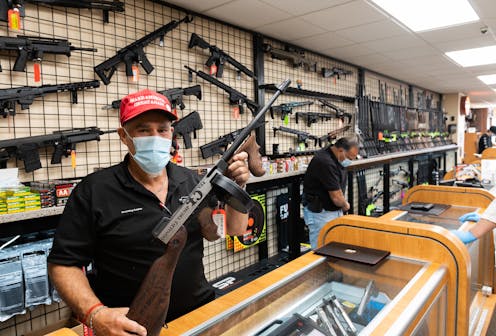An expert on trends in gun sales and gun violence in pandemic America
Gun sales have risen in recent years. An expert explains who and what is driving this trend and how it’s affecting Americans.

Gun sales have risen in recent years, particularly during the COVID-19 pandemic. On Feb. 28, 2022, SciLine interviewed Garen Wintemute – an emergency medicine physician at the University of California, Davis, Medical Center and director of the California Firearm Violence Research Center – about what’s driving this change and what gun usage and culture looks like in America two years into the pandemic.
The Conversation has collaborated with SciLine to bring you highlights from the discussion, which have been edited for brevity and clarity.
What does the research tell us about who owns guns in the United States and why?
Garen Wintemute: The traditional population of gun owners are white, non-Hispanic men. But for several years, the demographic profile of gun owners in the United States has been broadening as women and members of underrepresented groups started purchasing firearms. People buy guns more for protection than for all other reasons put together. The second-biggest reason is use in sport hunting and target shooting and so on.
Can you discuss recent increases in gun sales and factors driving the surge?
Garen Wintemute: An absolutely unprecedented increase in firearm sales has occurred over the last couple of years.
It started in January 2020 with the news of the emerging COVID-19 pandemic, and it grew through the spring of 2020 as people became concerned about the advent of violence in late spring and summer, continuing right through the fall. There was a federal election in 2020, which always drives gun purchases. And that election was accompanied by violence. Purchases reverted to expected levels only in the last couple of months of 2021 and now in the beginning of 2022.
What is known about the links among gun prevalence, gun purchasing trends and gun violence?
Garen Wintemute: We’ve known for a long time that the more access there is to firearms in a society, the more firearm violence there is likely to be. It’s been shown in comparisons of societies and U.S. states with different levels of firearm ownership.
During the pandemic, as purchasing picked up across the country, we learned there was – at least early on – a relationship between an increase in gun purchases above expected levels and a later increase in violence above expected levels. As 2020 went on, that signal was lost, except for domestic violence, because many other things were contributing to increases in violence.
Which demographic groups are harmed the most by gun violence?
Garen Wintemute: A very good and accessible source of information on this is the Centers for Disease Control and Prevention’s injury mortality data tool, WISQARS.
If we are talking about violence between people, men are at much greater risk than women, and men of color are at much greater risk than are white, non-Hispanic men. In particular, young Black men are at highest risk for homicide.
But if we talk about suicide, risk is higher with older age, not lower. Gender is related. Males are, again, at greater risk, but the group at highest risk is white, non-Hispanic men.
What should people know about “ghost guns” and other recent developments?
Garen Wintemute: “Ghost guns” is shorthand for privately manufactured firearms. They are firearms that are produced with no serial number so they’re not traceable if they’re used in a crime. And that’s where the term ghost guns comes from. In major cities in California, law enforcement agencies are reporting that 30%, 40%, 50% of all the guns they recover following use in a crime are these anonymously produced ghost guns.
[Like what you’ve read? Want more? Sign up for The Conversation’s daily newsletter.]
I believe they’re going to be a huge problem nationwide, as they are in California. They can be manufactured by individuals in their homes. There’s a special milling machine that’s about the size of a desktop laser printer. I could have 10 of them in my office, and each one of them would produce the key component for a ghost gun about every 30 minutes. I can buy all the other parts on the open market.
What gun violence trends are you following?
Garen Wintemute: There has been a rapid growth in the acceptance of the idea that violence is going to be necessary in order to keep America on the proper path. I’ll quantify: 10% of adults, about 25 million people, endorse the statement that violence is justified now to put Donald Trump back in office. Thirty percent of adults endorse the statement that President Biden was not legitimately elected.
People who study terrorism and violent extremism are very concerned that in this federal election year, and in 2024, we may see the advent of large-scale political violence.
Watch the full interview to hear more about the future of firearm research.
SciLine is a free service based at the nonprofit American Association for the Advancement of Science that helps journalists include scientific evidence and experts in their news stories.
Dr. Wintemute’s research is supported by the UC Davis Violence Prevention Research Program and grants from The California Wellness Foundation and the Heising-Simons Foundation.
Read These Next
RFK Jr. wants to scrutinize the vaccine schedule – but its safety record is already decades long
Federal officials are questioning the safety of the vaccine series children receive. Here’s the story…
Deception and lies from the White House to justify a war in Venezuela? We’ve seen this movie before
Two US wars based on lies, in which tens of thousands of American troops and millions of civilians died,…
Miami’s new mayor faces a housing affordability crisis, city charter reform and a shrinking budget
Eileen Higgins won a hard-fought election to become Miami’s new mayor. Now for the hard part – governing…






